I was planning on writing reviews for X-Wing's second edition epic ships and "Epic Battles" expansion packs (which released in the winter). But real-life happened. The COVID-19 pandemic put me and my gaming friends into lockdown. Having elderly relatives and other relatives with underlying health conditions, we took the lockdown advisory pretty seriously and didn't have in-person interactions with anybody other than limited in-person interactions with our immediate neighbors -- none of whom are board gamers (bummer). So I didn't get to play much X-Wing other than a couple rounds with my partner, and we didn't play any of the epic content because she's still learning 2nd edition and I didn't want to overwhelm her with new rules. So my thoughts on those expansions will have to wait until at least this fall, depending on how much game-playing I can do when the lockdowns are lifted during the summer, and assuming that there isn't a second lockdown this coming fall or winter.
In the meantime, Fantasy Flight was kind enough to not leave me completely high and dry. In early June, my loving partner sent me a link to the solo rules, and I decided to try them out. These rules were released at the end of May, in the waning days of the official lockdowns. I'm not sure if Fantasy Flight has this planned all along, or if they wrote it up quickly as a reaction to the pandemic. In either case, it's a considerate (albeit opportunistic) gesture from Fantasy Flight. It's just too bad these rules weren't published a month earlier. It would've given me more to do during the most boring stretches of the lockdown. Ah well. We have these rules for the next pandemic, I guess.
It's important to note that what I'm reviewing here is technically considered a "alpha test" of the rules. These rules are not finalized, and they may be subject to extensive changes as a result of player feedback before they officially release. If the rules change substantially for the official release, I may add an addendum to this review, or write a separate review. As of the time of this writing, the solo rules are freely available for download at Fantasy Flight's website. I do not know if Fantasy Flight is planning on eventually selling this as an actual expansion, or if the finalized version will remain free. So, you know, download it now. Just in case.
Fantasy Flight released official rules for playing X-Wing solo.
Best of all, these rules would probably work just fine in first edition as well. Players who haven't bought into second edition can still join in on the fun. You'll just have to improvise with regard to the hyperspace tokens, since those are the only components that are required for solo play, but which aren't in the first edition sets.
Dice for brains
The rules refer to the non-player ships as "solo ships", which I think is kind of confusing, since it sounds like the label refers to the solo player's ship(s). So call the non-player ships "NPC" ships (or "NPS" for "non-player ship", or "A.I." ships, or whatever you want to call them). In any case, the core conceit of the solo mode is that the player rolls a defense and attack die for each NPC ship when it activates, and then looks up the result in a behavior table to determine how each given NPC ship will behave. It's a simple enough concept that I'm surprised hasn't been in the rules earlier.
Roll dice, then look up the result in a table of possible moves.
The defense die is the principle determinant of the NPC ship's "attitude" (how it will behave). On an "evade" result, the ship will behave defensively or evasively. On a "focus" result, it will have a more balanced or passive posture. And on a "blank" result, it will behave more aggressively or boldly. This will largely determine the NPC ship's movement and action for the turn. The result of the red die will further modify the NPC ship's movement.
... [More]
The Dark Souls remaster was recently released, but it doesn't make enough [single player] improvements for me to really care to buy it. I might pick it up for the Switch when that gets released, because portable Dark Souls could be fun and interesting and fresh enough to warrant another purchase. However, the Switch version is being developed by another company, and it doesn't even support 60 fps, so I may not bother getting it anyway.
In the meantime, I decided to try out another "remaster" of sorts, and I got some friends together for some jolly cooperation in Steamforged Games' Kickstarted Dark Souls: the Board Game. This is a co-operative dungeon-crawler. I think the closest comparison that I can make is that it's a Dark Souls-themed variation on Descent: Journeys in the Dark. Unfortunately, Dark Souls: the Board Game doesn't seem to hold a candle to Descent.
Opening the box sets the tone of the game right away.
YOU DIED
The big mechanic that is imported from the video game is the inclusion of the video game's bonfire and respawn mechanics. Like in the video game, resting at the bonfire (or dying and being returned to the bonfire) resets everything. This includes all enemy encounters, as well as all the players' resources (such as the Estus Flask, Lucky Coin, or Pendant -- which actually has a function in the board game). However, a bit of the sense of attrition is also lost in translation, as your HP (and stamina) fully resets after each encounter. I think I would have preferred if the Estus Flask had a certain number of uses, but only restored a subset of your damage. That way, you'd retain some of your damage from encounter to encounter.
All the party's souls are dropped
on the spot where a character died.
Nevertheless, the Bonfire mechanic is probably the one mechanic that is most successfully translated from the video game source material. Despite the lack of health attrition, the desire to conserve as much resources as possible for the upcoming boss fight pressures the players into riskier play. Trying to conserve resources can lead to a lot of deaths.
Just like in the video game, if you die, all your souls are dropped on the floor where you died. If any one player dies, the whole party "dies" and is transported back to the Bonfire. The deeper into the dungeon you died, the more you have to fight through [again] in order to reclaim your souls. If you die again before reclaiming your dropped souls, all those souls are lost.
As I understand the rules, you can't leave an encounter once it's started, so you won't be making any "soul runs" to pick up your souls and then run back to the bonfire. You also can't open treasure chests until the encounter is won, which means you can't make suicidal "loot runs" either, which are a trademark strategy of the Souls video games. If you need to level up or buy new equipment in order to beat the encounter that killed you, you'll have to risk losing your dropped souls by farming against other encounters... [More]
36444b16-5d29-4691-9a3f-d2609ffee548|0|.0
Tags:Dark Souls, Dark Souls: the Board Game, Steamforged Games, Kickstarter, From Software, board game, dice, miniatures, grinding, co-op, David Carl, Alex Hall, Mat Hart, Richard Loxam, Hidetaka Miyazaki
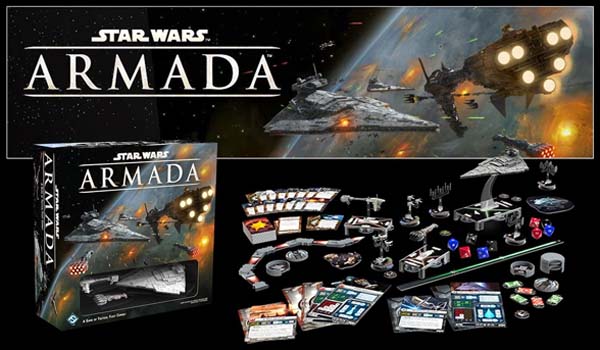
If you like the Star Wars: X-Wing miniatures game (and I do like it), or if you're eagerly awaiting the release of the second edition, but you don't want to house-rule that your car can act as a makeshift Star Destroyer, then Fantasy Flight has you covered. Star Wars: Armada is a higher-scale, tactical combat game using capital ships, and it might actually be a considerably better game than the core X-Wing set (at least better than the first edition)!
Planning ahead
Much like the board game Sails of Glory (which I also really like), Armada requires you to plan the actions of your capital ships a couple turns in advance. However, unlike Sails of Glory, it isn't the movement of these ships that you must pre-plan; it's their desired "commands". I was a little disappointed that the capital ships don't require that players plan their movement in advance, but then again, the maneuverability of these ships is highly limited, and only gets lower as the ship goes faster (if the ship in question even can go faster). There is a sense of inertia to these behemoth ships, but not quite the same level of inertia as the sailing ships of Sails of Glory.
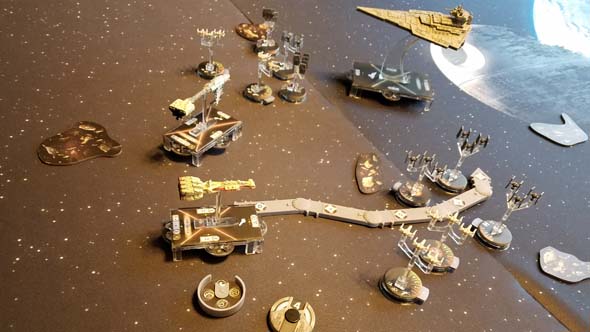
Ships move very slowly and have very limited maneuverability.
I do like that these ships both begin and end their movement relative to the font of their base. This alleviates the problems that X-Wing had with its large ships counter-intuitively moving faster than their smaller counterparts. And since the base Armada package comes with ships of varying sizes, this improvement is immediately noticeable without needing to wait for expansions: all ships move and turn at consistent speeds.
The rules do require that ships attack prior to moving. This means that you must plan ahead a little bit, since you have to position yourself for an attack in the turn prior, and have to anticipate who will have initiative and where their ship(s) will be if they get to move them before you get to make your attack.
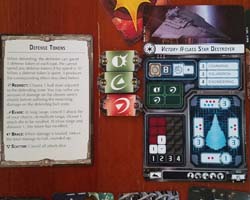
Defense tokens give players
more meaningful decisions.
More meaningful decisions
Even defense is a tactical decision! And this might be the single, best change from X-Wing. Instead of simply rolling defense dice to cancel out your opponent's attack rolls, you get to chose a set of defense tokens to apply, and each one mitigates damage in different ways. One defense token may allow you to cancel out an opponent's die roll, while another will allow you to redirect the damage to another hull section's shields, and yet another halves the total damage dealt. These tokens refresh each round, unless you use twice in the same round, in which case, it is permanently discarded.
This alleviates another of the problems that permeated X-Wing: that damaging an opponent often felt like playing craps. Getting into perfect position and lining up a point-blank shot against an opponent can be completely foiled by dice rolls in X-Wing. Dice still play a role in Armada, but damage seems to be much more consistently-dealt, and players actually have a say in how their ships defend themselves from damage. It gives the player more meaningful decisions... [More]
42a5d29c-7cc8-476d-8c33-ac96b6f42b8b|0|.0
Tags:Star Wars, Star Wars: Armada, Fantasy Flight, board game, miniatures game, capital ship, squadron, weapon arc, dice, maneuver, objective, James Kniffen, Christian T. Petersen
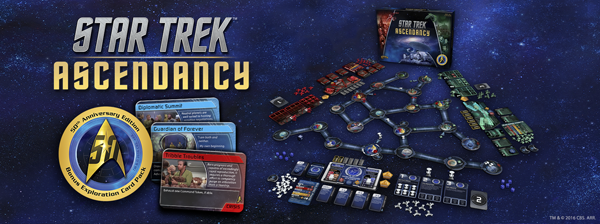
As I had mentioned in my Star Trek: Fleet Captains review, good Star Trek games are few and far between. Perhaps my favorite Trek game of all time is the Windows '98 4-x strategy game Birth of the Federation. BotF, developed my Microprose, was basically a Trek reskin of Master of Orion II. It was buggy, had cheating A.I., suffered from a major memory leak that slowed the game to a crawl after about 100 turns of play, and it didn't include any Original Series ships or technologies. But it did manage to faithfully capture Star Trek's spirit of exploration and discovery by being a game about exploring and colonizing a galaxy.
It wasn't a stripped-down startship combat simulator (Starfleet Command), or a cookie-cutter first-person shooter (Elite Force), or a lazy StarCraft clone (Armada), or an out-of-place dogfighter (Invasion), or a derivative WoW clone (Star Trek: Online). None of those games is terrible. I've played them all, and actually have some rather fond memories with most of them. But none of these games really meshed perfectly with the Star Trek license, and none of them really scratched my Star Trek gaming itch the way that Birth of the Federation did. Apparently, some designers at Gale Force Nine also like Birth of the Federation, because their new board game, Star Trek: Ascendancy, almost feels like a board game version of that classic Trek PC game.
Ascendancy is the first proper 4-x board game using the Star Trek license that I've seen. It certainly blows Fleet Captains out of the water. While Fleet Captains included some token exploration and territory-expansion mechanics as a supplement to the ship-to-ship combat that was the core of the game, Ascendancy is a game that is actually about exploring a procedurally-generated map, colonizing planets, and developing their resources. You can win by conquering other players' home worlds, or by developing your culture up to a specific level.
The final frontier is always in flux
The board of Star Trek: Ascendancy utilizes an interesting and novel modular board. Disk tiles represent planets, systems, and anomalies, each of which is connected by star lanes of varying distances. New systems and star lanes are drawn from a deck as the players explore, and so the board is constantly expanding as you play. It's nothing earth-shatteringly new, but it does have one neat gimmick that I haven't seen in other similar games.
The map will grow and change as the game progresses.
In addition to the board dynamically growing as the game progresses, systems are considered to be "floating" until they become locked in place by being connected to two or more systems via a star lane. This means that leaf systems can be freely rotated around to make room for other tiles to be placed in the play area. I believe this is intended to model the 3-dimensional nature of space. In a more practical sense, it means that the galaxy [map] can (and will) change its shape occasionally, leaving the true distances between locations ambiguous until everything gets locked down. [More]
7b9b6ce0-3004-4c0d-a534-30ff155f91cb|1|1.0
Tags:Star Trek, Star Trek Ascendancy, Gale Force Nine, board game, strategy, 4x, dice, Federation, Romulan, Klingon, exploration, phenomenon, trade, colonization, war, star lane, warp, warp drive, Aaron Dill, John Kovaleski, Sean Sweigart, Star Trek: Birth of the Federation
Almost a decade ago, my love of board-gaming was kick-started by a single game. That game was Fantasy Flight's Battlestar Galactica board game. For a period of a couple years, my friends and I were playing that game once or twice almost every month. Even after we started branching out to other games, BSG would regularly grace our tables.
The Battlestar Galactica board game kick-started my tabletop hobby.
Unfortunately, as time went on, members of the regular group(s) that I played with got new jobs, moved, started families, and it became harder and harder to get a large enough group together to play a 4 or 5-hour long board game. Eventually, BSG (along with all my other games) started collecting dust on a shelf.
It wasn't until a few years ago that I finally got back into having semi-regular board game sessions, thanks primarily to my girlfriend taking an interest in X-Wing. Most of our board gaming in the past years has been dominated by either quick group games (such as Dominion, One Night Ultimate Werewolf, Resistance, or Cards Against Humanity), or smaller, two-player games (like the aforementioned X-Wing). No one game has dominated in quite the same way that BSG did. I'd like to play it again, and maybe someday I'll even put up a review of it, but we haven't dusted the ol' game off because we rarely have the time for it. When we do have a whole evening cleared for an epic game, we try to play other games that we haven't already played the hell out of.
Well, clearly, I wasn't the only one who loved Battlestar Galactica, but wished it didn't take so bloody long to play, because Evan Derrick's 2011 game Dark Moon is basically a reskin of Battlestar Galactica that only takes an hour and a half to play. Dark Moon accomplishes this by reducing a lot of the mechanical complexity and by making progress in the game a lot more straight-forward. Virtually every mechanic or interaction in Dark Moon is a direct analog to a mechanic or interaction in BSG.
The shape-shifting space monster among us
The core conceit of Dark Moon (and Battlestar Galactica) is that the game is a semi-cooperative game in which most of the players are working together to try to prevent their moon-based mining station from falling apart around them. However, one or more of the players is secretly a shape-shifting alien (an "infected") who is trying to sabotage the station and kill all humans. Players take turns performing a single action to try to stabilize the deteriorating mining station. However, the most efficient action is to "issue an order" to another player to allow that player to take multiple actions. The catch is that the player you give the order to may secretly be a saboteur, so you have to be careful about only giving orders to other players who you trust.
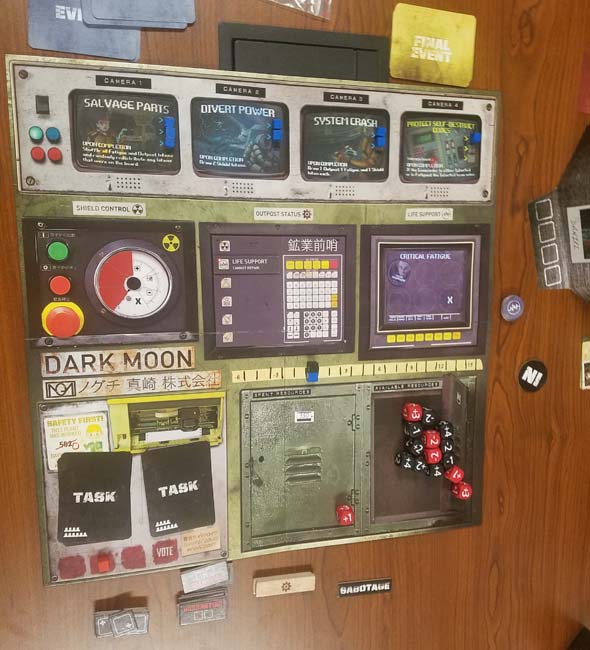
Players cooperate to complete a series of events, but some players are secretly traitors.
At the end of each player's turn, the entire group participates in a group task. Each task card has a pass or fail condition. Passing may result in positive effects for the uninfected players, and failing may result in harmful effects. These group tasks ensure that every player gets to participate in virtually every turn, so you're never sitting around twiddling your thumbs waiting for other players to do things. Even if you weren't participating in the turn, it would still behoove you to pay close attention to what's going on, if for nothing else than to look for any tells or indications that the current player may be an Infected... [More]
|

| 12 | | | | | | | 60 | | 11 | | | | | | | 55 | | 10 | | | | | | | 50 | | 09 | | | | | | | 45 | | 08 | | | | | | | 40 | | 07 | | | | | | | 35 | | 06 | | | | | | | 30 | | 05 | | | | | | | 25 | | 04 | | | | | | | 20 | | 03 | | | | | | | 15 | | 02 | | | | | | | 10 | | 01 | | | | | | | 05 |
|